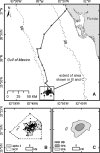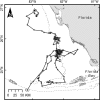Long-term behavior at foraging sites of adult female loggerhead sea turtles (Caretta caretta) from three Florida rookeries
- PMID: 24882883
- PMCID: PMC4033788
- DOI: 10.1007/s00227-014-2415-9
Long-term behavior at foraging sites of adult female loggerhead sea turtles (Caretta caretta) from three Florida rookeries
Abstract
We used satellite telemetry to study behavior at foraging sites of 40 adult female loggerhead sea turtles (Caretta caretta) from three Florida (USA) rookeries. Foraging sites were located in four countries (USA, Mexico, the Bahamas, and Cuba). We were able to determine home range for 32 of the loggerheads. One turtle moved through several temporary residence areas, but the rest had a primary residence area in which they spent all or most of their time (usually >11 months per year). Twenty-four had a primary residence area that was <500 km2 (mean = 191). Seven had a primary residence area that was ≥500 km2 (range = 573-1,907). Primary residence areas were mostly restricted to depths <100 m. Loggerheads appeared to favor areas with larger-grained sediment (gravel and rock) over areas with smaller-grained sediment (mud). Short-term departures from primary residence areas were either looping excursions, typically involving 1-2 weeks of continuous travel, or movement to a secondary residence area where turtles spent 25-45 days before returning to their primary residence area. Ten turtles had a secondary residence area, and six used it as an overwintering site. For those six turtles, the primary residence area was in shallow water (<17 m) in the northern half of the Gulf of Mexico (GOM), and overwintering sites were farther offshore or farther south. We documented long winter dive times (>4 h) for the first time in the GOM. Characterizing behaviors at foraging sites helps inform and assess loggerhead recovery efforts.
Figures





Similar articles
-
Loggerhead sea turtle (Caretta caretta) diving changes with productivity, behavioral mode, and sea surface temperature.PLoS One. 2019 Aug 7;14(8):e0220372. doi: 10.1371/journal.pone.0220372. eCollection 2019. PLoS One. 2019. PMID: 31390354 Free PMC article.
-
Deep vs shallow: GPS tags reveal a dichotomy in movement patterns of loggerhead turtles foraging in a coastal bay.Mov Ecol. 2024 May 30;12(1):40. doi: 10.1186/s40462-024-00480-y. Mov Ecol. 2024. PMID: 38816732 Free PMC article.
-
Sympatry or syntopy? Investigating drivers of distribution and co-occurrence for two imperiled sea turtle species in Gulf of Mexico neritic waters.Ecol Evol. 2018 Nov 26;8(24):12656-12669. doi: 10.1002/ece3.4691. eCollection 2018 Dec. Ecol Evol. 2018. PMID: 30619571 Free PMC article.
-
Habitat use of loggerhead (Caretta caretta) and green (Chelonia mydas) turtles at the northern limit of their distribution range of the Northwest Pacific Ocean.PLoS One. 2024 Apr 4;19(4):e0290202. doi: 10.1371/journal.pone.0290202. eCollection 2024. PLoS One. 2024. PMID: 38573996 Free PMC article.
-
Migration, foraging, and residency patterns for Northern Gulf loggerheads: implications of local threats and international movements.PLoS One. 2014 Jul 30;9(7):e103453. doi: 10.1371/journal.pone.0103453. eCollection 2014. PLoS One. 2014. PMID: 25076053 Free PMC article.
Cited by
-
Loggerhead sea turtle (Caretta caretta) diving changes with productivity, behavioral mode, and sea surface temperature.PLoS One. 2019 Aug 7;14(8):e0220372. doi: 10.1371/journal.pone.0220372. eCollection 2019. PLoS One. 2019. PMID: 31390354 Free PMC article.
-
Confirmation of significant sea turtle nesting activity on a remote island chain in the Gulf of Mexico.Ecol Evol. 2023 Aug 21;13(8):e10448. doi: 10.1002/ece3.10448. eCollection 2023 Aug. Ecol Evol. 2023. PMID: 37608924 Free PMC article.
-
Evolutionary Comparisons of Chelonid Alphaherpesvirus 5 (ChHV5) Genomes from Fibropapillomatosis-Afflicted Green (Chelonia mydas), Olive Ridley (Lepidochelys olivacea) and Kemp's Ridley (Lepidochelys kempii) Sea Turtles.Animals (Basel). 2021 Aug 25;11(9):2489. doi: 10.3390/ani11092489. Animals (Basel). 2021. PMID: 34573455 Free PMC article.
-
Deep vs shallow: GPS tags reveal a dichotomy in movement patterns of loggerhead turtles foraging in a coastal bay.Mov Ecol. 2024 May 30;12(1):40. doi: 10.1186/s40462-024-00480-y. Mov Ecol. 2024. PMID: 38816732 Free PMC article.
-
Sympatry or syntopy? Investigating drivers of distribution and co-occurrence for two imperiled sea turtle species in Gulf of Mexico neritic waters.Ecol Evol. 2018 Nov 26;8(24):12656-12669. doi: 10.1002/ece3.4691. eCollection 2018 Dec. Ecol Evol. 2018. PMID: 30619571 Free PMC article.
References
-
- Amante C, Eakins BW (2009) ETOPO1 1 arc-minute global relief model: procedures, data sources and analysis. NOAA Technical Memorandum NESDIS NGDC-24
-
- Arendt MD, Segars AL, Byrd JI, Boynton J, Whitaker JD, Parker L, Owens DW, Blanvillain G, Quattro JM, Roberts MA. Distributional patterns of adult male loggerhead sea turtles (Caretta caretta) in the vicinity of Cape Canaveral, Florida USA during and after a major annual breeding aggregation. Mar Biol. 2012;159(1):101–112. doi: 10.1007/s00227-011-1793-5. - DOI
-
- Balazs GH, Miya RK, Beavers SC (1996) Procedures to attach a satellite transmitter to the carapace of an adult green turtle, Chelonia mydas. In: Keinath JA, Barnard DE, Musick JA, Bell BA (comps) Proceedings of the 15th annual symposium on sea turtle biology and conservation. NOAA Technical Memorandum NMFS-SEFSC-387, pp 21–26
-
- Blumenthal JM, Solomon JL, Bell CD, Austin TJ, Ebanks-Petrie G, Coyne MS, Broderick AC, Godley BJ. Satellite tracking highlights the need for international cooperation in marine turtle management. Endang Species Res. 2006;2:51–61. doi: 10.3354/esr002051. - DOI
-
- Breland AJ (1980) Chemical and physical characteristics of a saline, geothermal spring off Florida’s southwest coast. Master’s thesis, University of South Florida
LinkOut - more resources
Full Text Sources
Other Literature Sources
